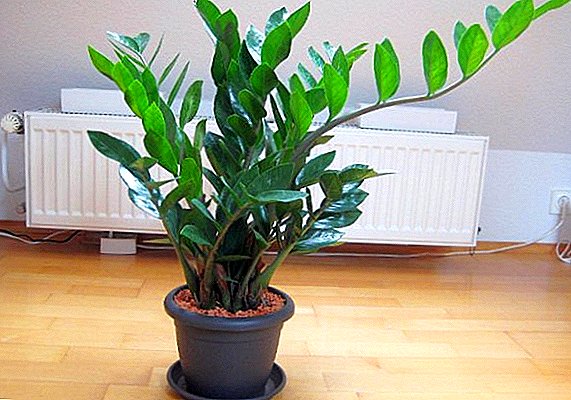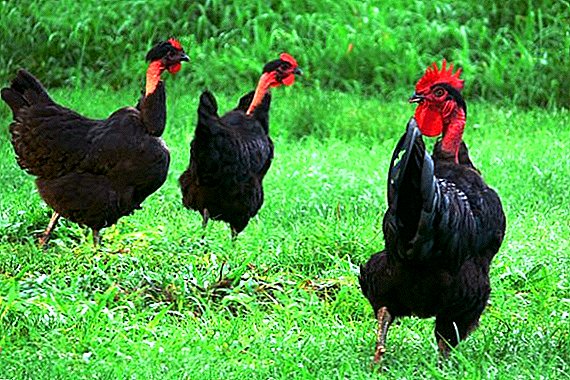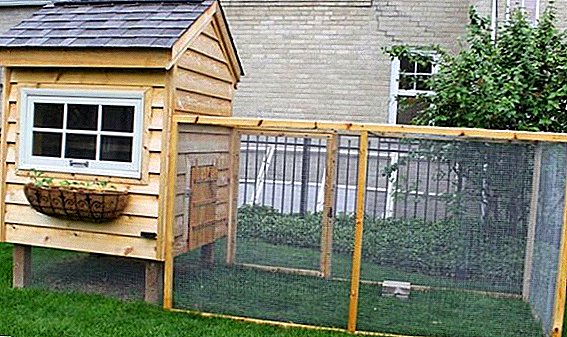 Many today breed domestic chickens for both meat and eggs. In order for the growing process to take place as efficiently as possible, the birds need to create favorable conditions. And first of all - to organize the room. How to make a chicken coop on your own for 10 chickens, we will tell you today.
Many today breed domestic chickens for both meat and eggs. In order for the growing process to take place as efficiently as possible, the birds need to create favorable conditions. And first of all - to organize the room. How to make a chicken coop on your own for 10 chickens, we will tell you today.
Choosing a place on the site
Before the start of construction work, the basic requirements for such a structure should be studied, namely the placement of the building:
- It is better to place a rectangular house from east to west.
- Chickens rush well when they have enough daylight, so windows should look to the south.
- It is better to have the chicken coop far away from noisy places and to take into account that there is not too damp - high humidity can cause diseases of chickens. To do this, it is desirable to place the chicken coop on a hill with a slight incline and equip it with ventilation.
Important! When designing the premises should be aware that the population will increase and will require more space.
When choosing a place to build, you should take into account the proximity of other premises, because chickens will need a place for walking. The best place for grazing is a plot under a tree or a shed. And the entrance to the house is better located on the south side. 
Design, Dimensions and Drawings
- The project and drawings will allow you to better imagine the future chicken coop. In addition, you can calculate in advance the budget of the construction itself.
- The size of the house is selected taking into account the fact that for 2 birds accounted for 1 square meter. In constrained conditions, the bird will not be carried. For ten chickens there will be enough a 2x2 meter house.
- Every construction begins with drawings. They should not be neglected - regardless of the scale, the drawing must be extremely clear and detailed. Only in this way can you see visually what you want to receive and develop a plan for further actions.
- When creating a drawing, it is not at all necessary to copy existing projects. This will be the uniqueness of your chicken coop - it will be built at your discretion and depending on the characteristics of the selected site and ideas about bird comfort.
- The scheme is drawn simply: a future structure is depicted on a piece of paper, door and window openings are determined. However, if you do not have enough construction experience, you can use ready-made schemes.
- When building a chicken coop, it is important not to forget that the room should not be too hot - at temperatures above + 25 ° C chickens will not carry eggs.
- In the cold season, the birds need to provide heat. In the cold need insulation. The temperature in the house should not be below + 12 ° C.
Did you know? In Israel, the egg production of chickens is increased by hanging colorful toys in a hen house. Thus, to relieve tension, the birds do not peck their kinsmen, but toys. So farmers have achieved a significant reduction in livestock mortality.
- When designing you should not forget about the place for walking. When a chicken coop area of 2 square meters. meters the minimum size of the enclosure should be equal to 2x6 m.
 Chicken coop for 10 chickens: A - facade; B - view from the vestibule; B - the general plan of the chicken coop
Chicken coop for 10 chickens: A - facade; B - view from the vestibule; B - the general plan of the chicken coopMaterials and tools
Before you start building a chicken coop, you need to prepare the tools and materials:
- The best material for a chicken coop is wood.
- The foundation will require brick and cement. And as insulation, sawdust, mineral wool or roofing felt are used.
- Aviary for walking can be built from a metal grid. At the same time, the fence should be of such a height that chickens do not fly out. In addition, the aviary should be equipped with a canopy. It will provide protection from the sun in hot weather, as well as from rain.
We recommend reading about how to build a chicken coop for 20, 30 and 50 chickens.
In addition to the above, it is necessary to prepare such tools and materials:
- hammer;
- fasteners (screws, corners, nails);
- concrete mixer;
- level;
- roulette, ruler;
- foam;
- paint;
- shovel;
- hacksaw, circular saw, screwdriver.

How to make a mini chicken coop for 10 chickens
In fact, building a chicken coop with your own hands is not at all difficult. If you stick to a simple plan, all work can be done quickly and clearly.
Foundation and floor
In order for the future structure to stand firmly, a foundation should be laid.
And the process itself goes through the following stages:
- pegs and thread mark the dimensions of the structure;
- before laying the foundation, remove the top layer of earth to a depth of 35 cm;
- the site allotted for construction is covered with a ten-centimeter layer of gravel and sand;
- for the formwork they take wooden planks 25 cm thick.
Important! Further work is carried out only after 2-3 weeks.With the help of fittings with a thickness of 8 mm, install the batten and fill it with concrete. The site should be equal to the size of the future structure.
 For flooring using wooden, well-dried bars, which are placed on the base.
For flooring using wooden, well-dried bars, which are placed on the base.Walls and windows
The coop must have warm, windproof walls. On a monolithic foundation, they can be built from lightweight materials (foam or gas concrete, porous ceramics or sawdust concrete). You can build shield formwork and fill it with layers of alumina solution.
You need to make the final decision based on preferences and planned budget. The main thing - that the material was easy to install. Before installing the walls, the foundation is waterproofed. To do this, use bitumen grease or roofing material.
Some recommend building brick walls: they will give the house a beautiful and solid look. However, one brick is not enough - the chicken coop will be cold. In addition, for a small chicken coop brick walls will be unprofitable.
Important! Windows can be either several or one. The main condition - the area of the windows should not be less than 10% of the floor area (ideally - 20-30 %).Do not forget about the windows, otherwise you will have to additionally illuminate the room. Since chickens do not rush in the dark, both natural and artificial lighting should be sufficient. It is best to have window openings on the sunny side. This option will provide light in a satisfactory amount, even in winter.

Roof and ceiling
There are several variants of roofs for the chicken coop, each of which has its own advantages:
- single slope. Easy to install, inexpensive, good rain removal. The only condition - the angle of inclination should be 30º. Bars strengthened at a distance of 50 cm from each other and placed waterproofing (roofing material, etc.);
- gable More complicated, but there is the option of creating an attic to store any chicken supplies. Ramps do different scales. Acceptable angle between the slopes - 40º.
For insulation inside the roof stitch chipboard or boards, and on top covered with slate or corrugated flooring.
Important! Since the main function of the roof is to prevent the ingress of moisture inside, the structure should not have any gaps or openings.During construction, it should be borne in mind that the height of the building should be sufficient so that work on cleaning the room and collecting eggs does not cause inconvenience. As a rule, the height of the ceiling is calculated on the basis of its own height, so that it is above the level of the head.

Ventilation
Windows will take over some of the airing. Constantly keeping them open is not an option. This is especially dangerous in cold weather. Chickens do not tolerate drafts.
Read more about how to make ventilation in the chicken coop.
That is why in the chicken coop install ventilation. To this end, a vent is mounted above the perch, the edges of which extend beyond the roof. Another, inlet pipe should be located in a remote corner of the house at an average of 40-50 cm from the floor.
Arrangement of the house
As soon as the main construction work is completed, you can begin to equip the coop. In this case, also make up a scheme in advance.
Perches
The main attention is paid to such elements as perches, namely to their number and size. The ideal material for this design is wood. To prevent injury to chickens, the crossbar is ground for roundness. Since the chicken coop must be processed periodically, the poles must be removable:
- Roosts are laid at a height of 40-60 cm from the floor and at a distance of 55 cm from each other.
- The total length of perches for ten individuals must be at least 2.5 meters.
- To facilitate the cleaning procedure, it is recommended to place pallets under the crossbars.

Nest
They do not need to be installed directly in the room: you can make a separate extension. To facilitate nest care, the structure is equipped with a door and an opening lid. Regardless of which option you choose, it should be foreseen when designing.
In the hen-house for 10 birds there should be 2-4 nests (at the rate of 3-4 individuals per one nest) with dimensions of 40x30x30 cm. Wooden boxes, baskets or basins can be used as containers. All of them should be located in a secluded, quiet corner.
Feeders and drinkers
Tanks for food and drink, it is desirable to have along the walls, opposite the perches. In the design for feeding, you will need a door, with which you can easily clean the feeder and fill it with new food. The optimal distance of drinking bowls and feeders from the floor is 5-10 cm.
We advise you to read about how to make a roost on your own, a nest with an egg pickup, a drinking trough and a feeder (automatic and bunker) for chickens.
Litter
A floor can be laid on top of the floor. It will help maintain cleanliness and allow you to maintain hygiene in the hen house. In the warm season it can be a flooring of small thickness, and for winter the layer should be 20-25 cm high.  You can use various materials as litter:
You can use various materials as litter:
- peat;
- sawdust;
- sand;
- foliage;
- shavings;
- straw.
Walking yard
No matter how spacious and comfortable the chicken coop is, you can’t do without a paddock. The most common fence for the courtyard - galvanized mesh-chain-link.
Important! For 10 individuals 10 will be enough.-15 sq.m. space.
First, they define the boundaries of the aviary and drive in metal or wooden posts. They are stretched on the net and secured with strong wire. The grid cells should be 1-1.5 cm. From one section you can make a gate for entry.  For an exit to the open-air cage from a chicken coop establish a ladder. In order for the birds not to crawl out of the cage, the ground is being digged under the net. And to the border of your yard, the distance from the aviary should be no less than 4 meters.
For an exit to the open-air cage from a chicken coop establish a ladder. In order for the birds not to crawl out of the cage, the ground is being digged under the net. And to the border of your yard, the distance from the aviary should be no less than 4 meters.
Winter insulation
In winter, the house must be comfortable and warm. Therefore, additional warming is an important point. To support a comfortable climate inside the surface of the walls sheathed with a base of wooden slats or bars.
Between them lay insulation (foam, straw, sawdust, mineral, glass or ecowool, etc.), fill the gap foam. The frame on top can be covered with sheets of plywood, clapboard, chipboard or fiberboard.
It will be useful for you to read about how to prepare a chicken coop for the winter with your own hands.
Some poultry farmers consider that it is not necessary to heat the room for birds in winter. However, this approach is wrong. Even with perfect warming the chicken coop is not enough. In the cold season it is better to equip the house with oil heaters or infrared lamps.
Video: how to make a chicken coop for 10 chickens Summing up, I would like to note that with a balanced approach to the construction of the chicken coop, you can make a cozy and reliable shelter. And the quality of the home will be at the level even when using inexpensive materials.
Did you know? Recently, scientists have hypothesized that chickens are the only modern descendants of tyrannosaurs. They are perfectly orientated in space, run well, have excellent vision and can choose the tactics of attack.












